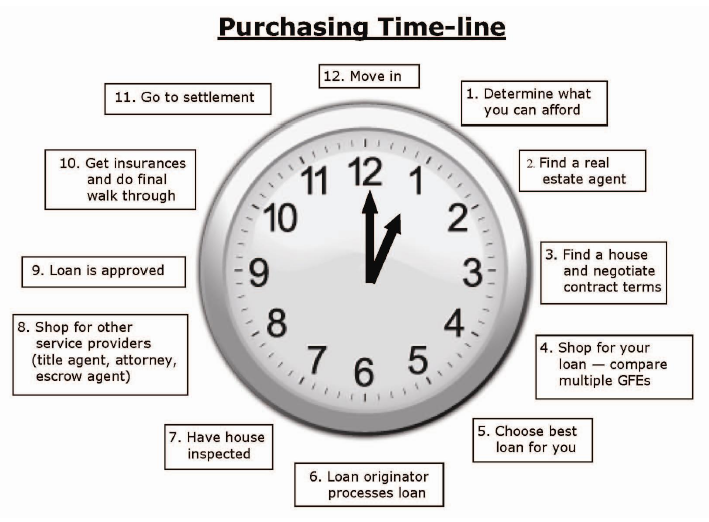HUD has unveiled their new "Shopping for your Home Loan – HUD's Settlement Cost Booklet". What was once a ppamphlet that was included with your loan application has been replaced by a 49 page booklet. This revised guide for borrowers was created to accompany HUD's new Good Faith Estimate which goes into effect on January 1, 2010.
HUD's new guide is to help consumers navigate the new Good Faith Estimate. I'm not going to go all the way through it on this post, I do want to point out issues with HUD's Home Purchasing Time Line (which you'll find on page 4).
Do you see anything wrong with this picture? Let's review step by step.
1. Determine what home you can afford. I agree with this. What home you can afford may be different than what home you qualify for. You don't have to buy as much home as you may qualify for and you might qualify for less than you desire. What's most important is being able to afford the home. I think this step is referring to doing some serious gut checking and reviewing of your personal budget BEFORE meeting with a real estate agent or mortgage originator.
2. Find a real estate agent. I think step two should be to find a mortgage professional instead of the agent. They have the cart before the horse with this step. The last thing a home buyer needs is to be shown a bunch of home they may not qualify for. Meeting with a mortgage originator first will help them narrow down what programs they qualify for that will suit their financial needs (I think this is HUD's Step 5). Agents may debate me on this because they like to direct buyers to their preferred lender.
3. Find a home and negotiate the terms. This is unbelievable! HUD is recommending that you enter into a binding contract before knowing if you're approved for the mortgage. Yes there are financing contingencies, but you do not tie up a seller's property when you don't even know that you can close on a transaction. Plus, most real estate agents will not show you a home until you have been preapproved by a mortgage professional.
4. Shop for your loan — compare multiple good faith estimates. This is very flawed. HUD's new good faith estimate carries RESPA reform which in a nutshell means that if a mortgage originator provides a borrower a good faith estimate, they are presumed by HUD to have obtained enough information from you to have created a loan application. This creates a certain amount of liability for the mortgage originator that in this day and age, most will not accept. Not to mention that rates change constantly, sometimes several times a day. If anything, you should shop for the most qualified mortgage professional and not "the loan" or rate…this step should take place around Step 2.
5. Chose the loan that's best for you. This should take place at step 2 or 3 (after you select your mortgage professional). This is too late in the game to be determining your financing.
6. Loan originator processes the loan. Your mortgage originator begins processing your loan at application for purposes of preparing your preapproval letter. Your loan may actually go into processing and underwriting once you are proceeding with your transaction.
7. Have house inspected. This typically take place after you find your home and have negotiated your contract. You're not going to want to be paying for an appraisal (which would take place at processing) if your potential home doesn't pass inspection.
8. Shop for other service providers (title, attorney, escrow agent). Is this a HUD after thought? If you are going to shop for your title or escrow, you're going to need to do this prior to the contract being written as the purchase and sales agreement dictates who the providers will be (unless the agent writes "buyers choice"). Plus, HUD's new GFE dictates how much the title and escrow fees can change at closing based on if you shop or if you allow the lender to select these service providers.
9. Loan is approved. There are different steps of loan approval. This is most likely "final loan approval" meaning all conditions (documentation) have been provided and reviewed by underwriting.
10. Get insurances and do final walk through. I recommend shopping and selecting your home owners insurance much earlier in the process. Once you have a bona fide contract and your home has passed inspection, you can start shopping for your insurance agent.
11. Go to settlement. In Washington, you're probably going to your signing appointment at the escrow company a couple days before closing. Sometimes signing will feel like it's at the eleventh hour!
12. Move in.
Watch formy next post where I share how I think this purchasing time line should look.











Please leave a reply